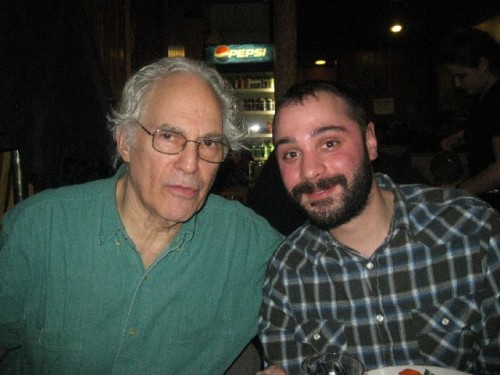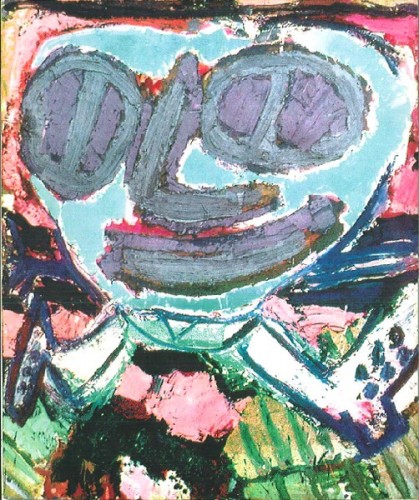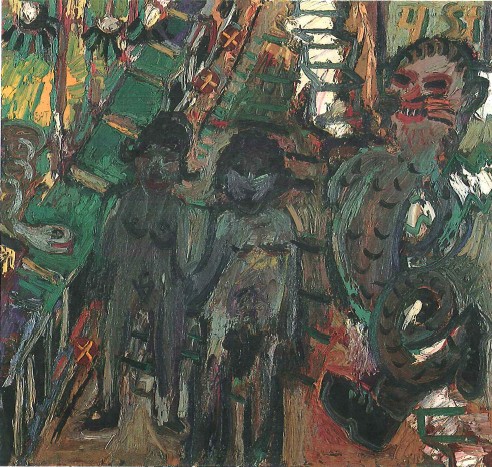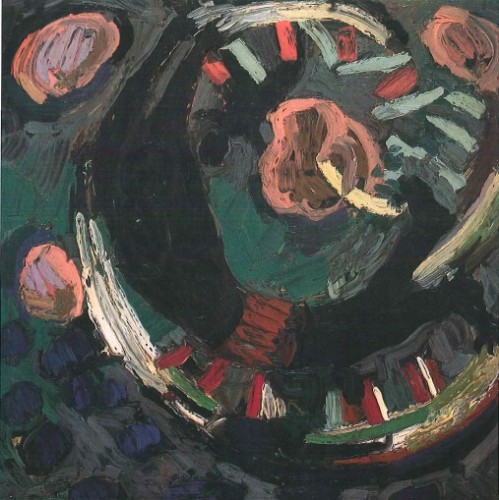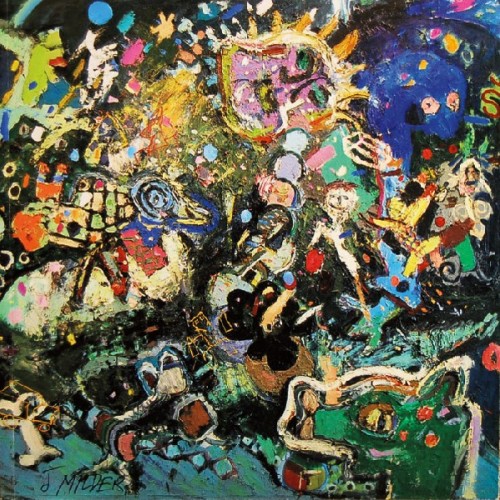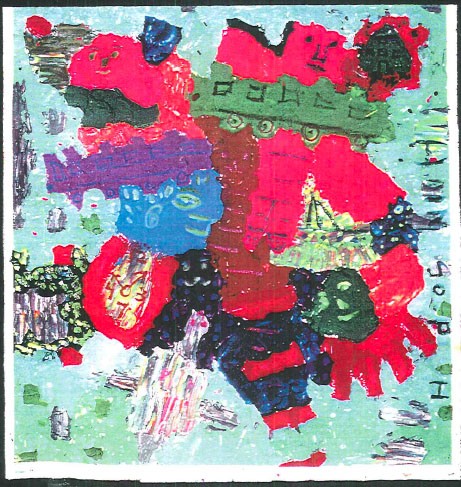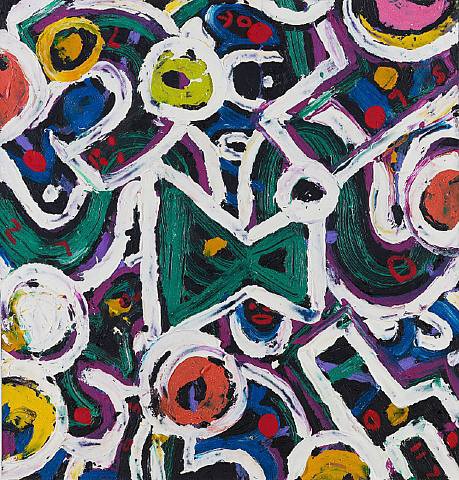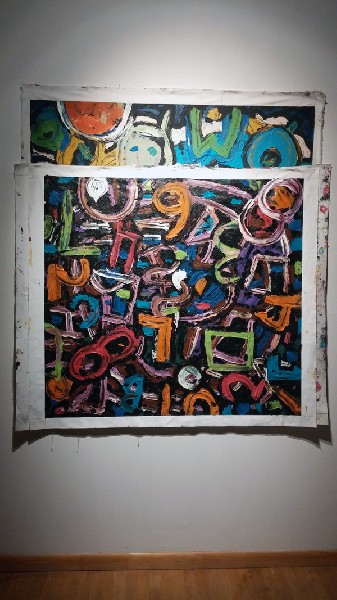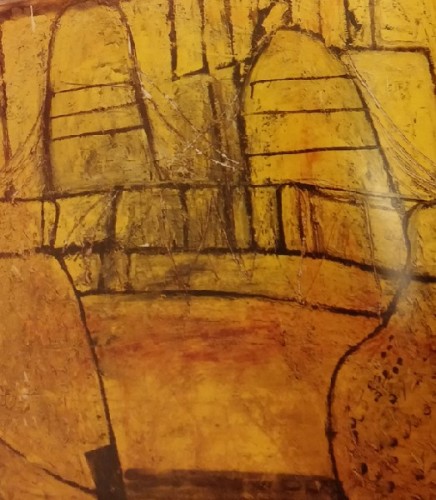Figurative Expressionist Artist Jay Milder
Unblotting the Rainbow
By: Adam Zucker - Nov 20, 2014
Jay Milder was born in Omaha, Nebraska in 1934. His ancestry connects him to the Baal Shem Tov (1698-1760), the patriarch of Hasidism and mystical Judaism, and the Hasidic mystic Rebbe Nachman (1772-1810) of Breslov, who founded a branch of Hasidic Judaism that emphasizes joy and intensity in living life through God.
Beginning in his later teenage years, Milder would begin to explore this mystical lineage, which fueled him with a desire to journey across the globe. Milder began his travels at the age of twenty, when he went to Paris to study the cubist style of painting at La Grande Chaumiere and the Sorbonne. He also took painting classes with Andre L’Hote (1885-1962) and studied sculpture with the Russian born sculptor, Ossip Zadkine (1890-1967).
Milder later recalled that he received praise from his teachers for incorporating a very rough, expressionistic, and organic approach to the Cubist style. Zadkine introduced Milder to the work of Chaim Soutine (1893-1943).
The paintings of Soutine would influence Milder’s signature blending of organic Cubism and spontaneous Figural Expressionism coupled with his unique interest in Helena Blavatsky’s (1831-1891) teachings of Theosophy, which unified the ancient spiritual religions of the world, and organized the fundamental nature of various spiritual teachings into a comprehensive synthesis.
After Paris, Milder traveled to Morocco in late 1954, where he lived briefly in the Arabic section of Tetouan. Like Paris, North Africa has a rich painterly history that inspired many of the great modernists, together with its colorful environment and daily life. For Milder, his time in North Africa would be key to developing a vibrant palette that became even bolder and more energetic over the years. Following a brief period from 1956 to 1957 at the School of the Art Institute of Chicago, Milder traveled to Mexico, where he exhibited in Puebla and where he received the Mexican government’s Honor Award for artists. Milder then traveled to Provincetown in the summer of 1958, where he initially planned to study painting at Hans Hofmann’s (1880-1966) school; however, while there he found the work of other artists of his own generation to be more compelling.
Milder came of age during the Second Generation of the New York School, an influential and pulsating community of visual artists, poets, and musicians. In New York, he established himself as part of a diverse group of painters, many of whom had studied with Hofmann. Milder’s generation was also significant in creating a lively artists’ scene in SoHo, then an industrial neighborhood in lower Manhattan. In 1958 Milder and Red Grooms (b. 1937) co-founded the City Gallery inside a Flat Iron loft at 24th Street and 6th Avenue that the artists shared.
Some of the artists who exhibited at the City Gallery included Bob Thompson (1937-1966), Christopher Lane (b. 1937), Peter Passuntino (b. 1936), Benny Andrews (1930-2006), Gandy Brodie (1925-1975), Wolf Kahn (b. 1929), Emilio Cruz (1938-2004), Robert Beauchamp (1923-1995), Norman Bluhm (1921-1999), Mimi Gross (b. 1940), Lester Johnson (1919-2010), Stephen Durkee (b, 1938), Robert Whitman (b. 1935), and Alex Katz (b. 1927). Claes Oldenburg (b. 1929) and Jim Dine (b. 1935), who would both become influential in the Pop Art movement, were given their first New York solo exhibitions at the City Gallery.
After Oldenburg was rejected by his peers to show at the Phoenix Gallery, Grooms and Milder dropped out of the Tenth Street collective gallery scene in protest and decided to invite Oldenburg to exhibit in their space. Grooms recalled, “We were reacting to Tenth Street. In '58 and '59, Tenth Street was sort of like SoHo is now, and it was getting all the lively attention of everyone downtown….We were just kids in our twenties, [but we] had a flair for attracting people to our openings.” (quote from Judith Stein from “Red Grooms the Early Years (1937-1960),” in the exhibition catalog for Red Grooms A Retrospective at the Pennsylvania Academy of the Fine Arts, 1985).
These artists also spent their summers in Provincetown, Massachusetts, the largest art colony in America, and a hotbed for avant-garde artists, writers, and actors. Milder and his contemporaries including Thompson, Mary Frank (b. 1933), Alex Katz, and Red Grooms, exhibited at Provincetown’s Sun Gallery, which was a breakthrough gallery that exposed the work of emerging figurative artists. It was during this period where Milder, and a group of like-minded Americans, explored the connections between spirituality and humanism by tapping into the subconscious and conflating gestural abstraction with archetypical signs and symbols. Milder, Thompson, and Grooms, along with established seminal artists including Jan Müller (1922-1958), Lester Johnson, Robert Beauchamp, George McNeil (1908-1995), Gandy Brodie, developed the mode of East Coast Figurative Expressionism, a significant succession to Abstract Expressionism.
Milder’s expressionist, allegorical scenes juxtapose the metaphysical world with contemporary life and, in so doing, explore elements of the unconscious and the spirit. He is endowed with a personal spirituality that comes from his observation and application of the Kabbalah, Maat Law, Eastern spiritual practices, Theosophy, and the liberal ideals of ancient and enlightenment era philosophers like Plato and Baruch Spinoza (1632-1677). Milder applies platonic thought, enlightenment philosophy, Jungian dream theory, and the esoteric teachings of Kabballah to Biblical tales combining contemporary life with pre-history.
The artist showed his first major series called "Subway Runners" in 1964 at the Martha Jackson Gallery in New York City. Martha Jackson organized one of the premier exhibition programs of Post-War American and European art. Jackson gave COBRA artist Karel Appel (1921-2006), Sam Francis (1923-1994), the British sculptor, Barbara Hepworth (1903-1975), William Scott (1913-1989), Billy Al Bengston (1934), the Canadian Paul Emile Borduas (1905-1960), Paul Jenkins (1923-2012), Alfred Jensen (1903-1981), Lester Johnson, Morris Louis (1912-1962), Louise Nevelson (1899-1988), the Spanish artist Antoni Tàpies (1923-2012), and Bob Thompson their first New York City exhibitions.
Milder's series of large-scale works was steeped in expression and energy from the urban environment. His "Subway Runners" materialize in flux, protruding out of the canvas plane. In these paintings, and others to follow, there is no central composition. It’s narrative, if any, is non-linear and there is not a traditional sense of form or structure in these works. He called these empirical paintings “manifestations,” as they represented his sojourn to self-realization, personal enlightenment and spirituality.
In the 1960s, he also painted a large series of work inspired by the Old Testament called “The Messiah Series.” By 1966 he had created over 200 medium sized works on canvas that show Biblical vignettes in a process that was very emblematic of the Figurative Expressionism mode that he came into being during the Mid-1950s. Some of the titles included "Jacob's Ladder"(1966), "Moses as Shepherd" (1966), "The Golden Calf" (1966), and "Scapegoat" (1966).
In 1987, twenty-eight of these paintings were displayed in at the Richard Green Gallery in New York City, and art critic Donald Kuspit, declared (in Artforum, December 1987) these paintings to be “Impressive enough for me to say…that after Nolde’s Biblical pictures, these are the best and most integral group of Biblical pictures of the 20th century.” In addition to a Biblical interpretation, Milder included his own perspective.
Having settled in New York City, Milder incorporated urban life into his work. He transfigured popular Old Testament tales to the subway and the streets of New York City. In works like "Expulsion IND" (1966), and "Inside the Ark I" (1970) he incorporates Old Testament tales into contemporary urban life. In these paintings, the allegory of original sin is reflected as a new myth, one in which the streets are paved with gold; as in the Garden of Eden, however, temptation has come—this time in the form of contemporary materialism. In such works Milder reveals an absurdist leaning, merging the sacred with the profane in mythical works that feature animals and humans reveling in sinful activities and portraying the corrupt visions of a man-oriented universe rather than a pantheistic universe. The figures in his canvases portray recurring symbols, intended as basic archetypes of humankind’s pursuit to make something that is at the same time elemental and informed by conscious intellect.
By working in a non-linear fashion, often revisiting previous ideas and methods—though always viewed through new empirical lenses—Milder's work builds naturally upon itself, evolving throughout the years based on the artist’s personal and spiritual explorations. His method often begins with him taking a passage from the Bible, and studying it in many lights, including its Hammurabic legal meaning, Talmudic and Midrashic meanings and all the commentary on it, even its Freudian counterparts.
This method allows Milder in his words to “distill all this information; and working in a trancelike revelation I am able to make new commentary on it.” To Milder these ancient and modern philosophies exhibit all aspects of a harmonic existence, into which we are all built. Every stroke or mark on the canvas is a result of his subconscious free-play, concerned more with the nature of self, than a representation of nature. He is as much a humanist as a mystic, exploring the potential for human beings to break free from the constraints of Western ideology and corruption, and experience a higher level of existence beyond our physical world.
Throughout his life, Milder has had experiences of personal enlightenment, both foreign and at home. These happenings come from sojourns to the Middle Eastern city of Tangier where he lived amongst the rich culture and history of Abrahamic civilization, and more recently, his studio in Easton, Pennsylvania, initially rich with Native American tribes including the Lenape, who were believed by some of the early colonial historians to be descendents of the lost tribe of Israel.
Milder is an alchemist painter, which is evident in the process in which color, shape, expression and form manifests on the canvas as he paints in a fluid and subliminal method. Overall, the work might be best described as contemporary cave painting or metaphysical graffiti, where anti-illusionistic symbols and sacred geometry express empirical and revelatory thinking in an urbanized form of composition. He also uses numerology, and Yoga chakra theory to create these vibrantly expressionistic manifestations that become a vessel for spiritual energy. Every Hebrew letter, word, number, even the accent on words of the Hebrew Bible contains an alternative meaning. Configurations of numbers (each Hebrew letter has a numerical value) relate their meanings to mystical energy. Milder’s use of numerology in paintings can be interpreted in many different ways as the Kabbalah teaches the methods of interpreting and making sense of each of these numerical constructs.
His quest is depicting the relationship between quantum mechanics, and the sacred geometry of Kabbalah. To Milder, the Kabbalah and Quantum Mechanics are interrelated. He says, "In Kabbalah matter is made manifest through harmonics and vibrations, curiously not unlike modern string theory.” He arrives at his compositions cosmologically where his figures are inseparable from their universe, thereby rejecting Western art’s ideology of arranging space within perspectival boundaries.
From early on, Milder experimented with radical techniques in painting using spray paint, volcanic ash, and other organic medium. Milder began using spray paint when it first appeared in commercial paint stores around 1959. This early use of spray paint and graffiti like process throughout Milder’s work would become a major influence on the American Neo-Expressionist painters, and more recently on the street artists in Brazil.
One of the seminal examples of Milder’s experimentation using spray paint and pigments on canvas akin to writing on walls was the 1959 painting "Bridge," a 50 x 50" monochromatic canvas layered in oil and spray paint with a recognizable geometric pattern scrawled and scraped from within the paint. Art historian Peter Selz referred to this painting in the catalog of Milder’s 1991 retrospective at the New England Center for Contemporary Art saying “the monochrome ochre in this painting is enlivened by black graffiti-like scratches.” Milder also developed his own formula for making pigments because he was using so much paint to make his large painterly constructs. Traditional artist’s paint was too expensive for the amount that he was going through.
Milder has continued to champion the art of painterly expressionism since the ‘60s, when Expressionism was superseded in popularity and practice by kitsch and the iconography of popular culture and mass-produced imagery in Pop Art.
In 1969, he was one of the founders of the Rhino Horn Group, a group of artists who were linked through their dedication to figurative art and by their collective notion that artistic practice should have both a critical and a social function. The group’s manifesto stated "Our art is involved with life; it is concerned with humanity, with emotion. We will not listen to explanations from or about the technically minded artist of yesterday. Just as abstract expressionism—the art of the fifties—was superseded by pop, op, hard edge, minimal and color field—the art of the sixties—so now a new art, a humanistic art, will characterize the seventies."
His continuation of Figurative Expressionism when the physical and emotional process of painting was falling out of style, presented an unmistakable link toward the well known Neo-Expressionist movement in the 1980s. Neo-Expressionism was, an international movement that was heralded as a return to brash and emotional expressionism using representational imagery. Celebrated American painters among Neo-Expressionist artists include Jean-Michel Basquiat (1960-1988), David Salle (b. 1952), Eric Fischl (b. 1948), Julian Schnabel (b. 1951), Susan Rothenberg (b. 1945), and Chuck Connelly (b. 1955). Other notables include the Germans Georg Baselitz (b. 1938) and Anselm Kiefer (b. 1945), and the Italians (known as the Transavanguardia) Francesco Clemente (b. 1952), Sandro Chia (b. 1946), and Enzo Cucchi (b. 1949).
The Neo-Expressionist painters’ use of mythic subjects and of a variety of media and painterly styles aligns their work most closely with that of Milder and his contemporaries like Thompson, Johnson, and Müller.
Basquiat, the most famous American Neo-Expressionist, went to high school with Milder's daughter Rifka and was familiar with his work at the time. This remarkable proximity has not gone unnoticed. In a New York Times review of a solo show of Jay Milder’s paintings in 1988, the critic Vivian Raynor wrote (in the New York Times, March 13, 1988) that "Even when figuration began trickling back in the early 1970s, Mr. Milder, who by that time was part of the ‘Rhino Horn’ group, was still on the wrong side of the fashion fence…. Mr. Milder is an Expressionist—one of several—who has remained visible despite his lack of careerism. It is time that someone looked into his case, if only to prevent the more-driven art scholars from re-launching him as a ‘father’ of Neo-Expressionism." Moreover, Robert C. Morgan, the well-known art historian, critic, and artist wrote in a 1986 review article “Basquiat’s style and subject matter are not unrelated to the [work of the] Rhino Horn group from the sixties [sic.]. They are particularly close to the work of Bob Thompson and Jay Milder.”
Since the late 1970s, Milder’s oeuvre has included a series of paintings referencing Noah’s Ark. He incorporates the Biblical story of Noah’s Ark to signify a boundless balance between the human spirit and the cosmos. The vibrant colors, organic figures (animals and human faces), and mystical numerology, are indicative of the “unblotting of the rainbow,” and the covenant between the individual and God that has become polluted through human corruption of the natural world.
In many of these paintings there are the words “Ein Sof,” or “Ayn Sof.” in Kabbalah, this is understood as God prior to his self-manifestation in the production of any spiritual Realm. Ein Sof may be translated as "no end", "unending", "there is no end", or infinite. Since the 1950s his realization was that when “Ein Sof” and Keter (the head Sephirot of the Tree of Life in Kabbalah) meet they create black infinity. This is the reason Milder has used black as the basis for his compositions which allows for forms to appear simultaneously fixed to the ground and floating in space. Another set of words that appear in some of his paintings titles is “Zim Zum,” which refers to Tzimtzum (meaning concealment and contraction). This term explains the doctrine of the Kabbalist rabbi Isaac Luria (1534-1572) to explain how God or Ein Sof which is infinite began the process of creation by contracting a part of his infinite light to create a conceptual space in which finite realms (humankind) could exist.
Milder’s work has drawn praise from around the world -- specifically in Brazil, where he has had several major exhibits. Milder has been the subject of retrospectives in Brazil in 1999 and 2003 at National Museum of Fine Arts of Rio de Janeiro; 2006, at the Museum of Modern Art, in Rio de Janeiro; and 2007 at the National Museum Brasilia. He is renowned in Sao Paulo, one of the major international centers for street and public art, as a seminal influence on contemporary graffiti artists. In 2009 Milder painted a mural on the Avenida Rebouças, a major thoroughfare in the city of Sao Paulo with renowned Brazilian street artist Eduardo Kobra, and was interviewed by print, on line, and TV media.
Milder continues to defy tradition and push the boundaries of the painted plane creating works of art that tap into the subconscious mind. The more one looks at these vessels of visual energy, the more is revealed about the human psyche and our relation to the primordial past, the continual present moment, and the developing future.

